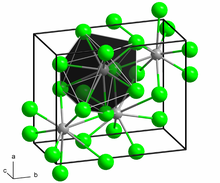BaCl
 |
|
 |
|
| Names | |
|---|---|
| Other names
Barium muriate
Muryate of Barytes Barium dichloride |
|
| Identifiers | |
|
|
|
3D model (JSmol)
|
|
| ChemSpider | |
| ECHA InfoCard | 100.030.704 |
| EC Number | 233-788-1 |
|
PubChem CID
|
|
| RTECS number | CQ8750000 (anhydrous) CQ8751000 (dihydrate) |
| UNII | |
|
|
|
|
| Properties | |
| BaCl2 | |
| Molar mass | 208.23 g/mol (anhydrous) 244.26 g/mol (dihydrate) |
| Appearance | White solid |
| Density | 3.856 g/cm3 (anhydrous) 3.0979 g/cm3 (dihydrate) |
| Melting point | 962 °C (1,764 °F; 1,235 K) (960 °C, dihydrate) |
| Boiling point | 1,560 °C (2,840 °F; 1,830 K) |
| 31.2 g/100 mL (0 °C) 35.8 g/100 mL (20 °C) 59.4 g/100 mL (100 °C) |
|
| Solubility | soluble in methanol, insoluble in ethanol, ethyl acetate |
| -72.6·10−6 cm3/mol | |
| Structure | |
|
orthogonal (anhydrous) monoclinic (dihydrate) |
|
| 7-9 | |
| Thermochemistry | |
|
Std enthalpy of
formation (ΔfH |
−858.56 kJ/mol |
| Hazards | |
| Safety data sheet | See: data page |
|
EU classification (DSD) (outdated)
|
Toxic (T) Harmful (Xn) |
| R-phrases (outdated) | R20, R25 |
| S-phrases (outdated) | (S1/2), S45 |
| NFPA 704 | |
| Flash point | Non-flammable |
| Lethal dose or concentration (LD, LC): | |
|
LD50 (median dose)
|
78 mg/kg (rat, oral) 50 mg/kg (guinea pig, oral) |
|
LDLo (lowest published)
|
112 mg Ba/kg (rabbit, oral) 59 mg Ba/kg (dog, oral) 46 mg Ba/kg (mouse, oral) |
| US health exposure limits (NIOSH): | |
|
PEL (Permissible)
|
TWA 0.5 mg/m3 |
|
REL (Recommended)
|
TWA 0.5 mg/m3 |
|
IDLH (Immediate danger)
|
50 mg/m3 |
| Related compounds | |
|
Other anions
|
Barium fluoride Barium bromide Barium iodide |
|
Other cations
|
Beryllium chloride Magnesium chloride Calcium chloride Strontium chloride Radium chloride Lead chloride |
| Supplementary data page | |
|
Refractive index (n), Dielectric constant (εr), etc. |
|
|
Thermodynamic
data |
Phase behaviour solid–liquid–gas |
| UV, IR, NMR, MS | |
|
Except where otherwise noted, data are given for materials in their standard state (at 25 °C [77 °F], 100 kPa).
|
|
|
|
|
| Infobox references | |
Barium chloride is the inorganic compound with the formula BaCl2. It is one of the most common water-soluble salts of barium. Like most other barium salts, it is colorless, toxic, and imparts a yellow-green coloration to a flame. It is also hygroscopic, converting first to the dihydrate BaCl2(H2O)2. It has limited use in the laboratory and industry.
BaCl2 crystallizes in two forms (polymorphs). One form has the cubic fluorite (CaF2) structure and the other the orthorhombic cotunnite (PbCl2) structure. Both polymorphs accommodate the preference of the large Ba2+ ion for coordination numbers greater than six. The coordination of Ba2+ is 8 in the fluorite structure and 9 in the cotunnite structure. When cotunnite-structure BaCl2 is subjected to pressures of 7–10 GPa, it transforms to a third structure, a monoclinic post-cotunnite phase. The coordination number of Ba2+ increases from 9 to 10.
In aqueous solution BaCl2 behaves as a simple salt; in water it is a 1:2 electrolyte and the solution exhibits a neutral pH. Its solutions react with sulfate ion to produce a thick white precipitate of barium sulfate.
...
Wikipedia

